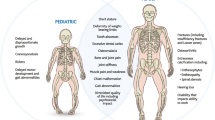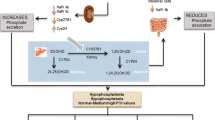Abstract
X-linked hypophosphatemia (XLH) is caused by mutations in the PHEX gene, which increase circulating levels of the phosphaturic hormone, fibroblast growth factor 23 (FGF23). Because XLH is a dominant disease, one mutant allele is sufficient for manifestation of the disease. However, the dosage effect of a PHEX mutation in XLH is not completely understood. To examine the effect of Phex genotypes, we compared serum biochemistries and skeletal measures between all five possible genotypes of a new murine model of XLH (Phex K496X or Phex Jrt). Compared to sex-matched littermate controls, all Phex mutant mice had hypophosphatemia, mild hypocalcemia, and increased parathyroid hormone and alkaline phosphatase levels. Furthermore, mutant mice had markedly elevated serum Fgf23 levels due to increased Fgf23 expression and reduced cleavage of Fgf23. Although females with a homozygous Phex mutation were slightly more hypocalcemic and hypophosphatemic than heterozygous females, the two groups had comparable intact Fgf23 levels. Similarly, there was no difference in intact Fgf23 or phosphorus concentrations between hemizygous males and heterozygous females. Compared to heterozygous females, homozygous counterparts were significantly smaller and had shorter femurs with reduced bone mineral density, suggesting the existence of dosage effect in the skeletal phenotype of XLH. However, overall phenotypic trends in regards to mineral ion homeostasis were mostly unaffected by the presence of one or two mutant Phex allele(s). The lack of a gene dosage effect on circulating Fgf23 (and thus phosphorus) levels suggests that a Phex mutation may create the lower set point for extracellular phosphate concentrations.



Similar content being viewed by others
References
Endo I, Fukumoto S, Ozono K, Namba N, Tanaka H, Inoue D, Minagawa M, Sugimoto T, Yamauchi M, Michigami T, Matsumoto T (2008) Clinical usefulness of measurement of fibroblast growth factor 23 (FGF23) in hypophosphatemic patients: proposal of diagnostic criteria using FGF23 measurement. Bone 42:1235–1239
Jonsson KB, Zahradnik R, Larsson T, White KE, Sugimoto T, Imanishi Y, Yamamoto T, Hampson G, Koshiyama H, Ljunggren O, Oba K, Yang IM, Miyauchi A, Econs MJ, Lavigne J, Juppner H (2003) Fibroblast growth factor 23 in oncogenic osteomalacia and X-linked hypophosphatemia. N Engl J Med 348:1656–1663
Yamazaki Y, Okazaki R, Shibata M, Hasegawa Y, Satoh K, Tajima T, Takeuchi Y, Fujita T, Nakahara K, Yamashita T, Fukumoto S (2002) Increased circulatory level of biologically active full-length FGF-23 in patients with hypophosphatemic rickets/osteomalacia. J Clin Endocrinol Metab 87:4957–4960
Kurosu H, Ogawa Y, Miyoshi M, Yamamoto M, Nandi A, Rosenblatt KP, Baum MG, Schiavi S, Hu MC, Moe OW, Kuro-o M (2006) Regulation of fibroblast growth factor-23 signaling by klotho. J Biol Chem 281:6120–6123
Urakawa I, Yamazaki Y, Shimada T, Iijima K, Hasegawa H, Okawa K, Fujita T, Fukumoto S, Yamashita T (2006) Klotho converts canonical FGF receptor into a specific receptor for FGF23. Nature 444:770–774
Shimada T, Hasegawa H, Yamazaki Y, Muto T, Hino R, Takeuchi Y, Fujita T, Nakahara K, Fukumoto S, Yamashita T (2004) FGF-23 is a potent regulator of vitamin D metabolism and phosphate homeostasis. J Bone Miner Res 19:429–435
Larsson T, Marsell R, Schipani E, Ohlsson C, Ljunggren O, Tenenhouse HS, Juppner H, Jonsson KB (2004) Transgenic mice expressing fibroblast growth factor 23 under the control of the alpha1(I) collagen promoter exhibit growth retardation, osteomalacia, and disturbed phosphate homeostasis. Endocrinology 145:3087–3094
HYP Consortium (1995) A gene (PEX) with homologies to endopeptidases is mutated in patients with X-linked hypophosphatemic rickets. Nat Genet 11:130–136
Ichikawa S, Traxler EA, Estwick SA, Curry LR, Johnson ML, Sorenson AH, Imel EA, Econs MJ (2008) Mutational survey of the PHEX gene in patients with X-linked hypophosphatemic rickets. Bone 43:663–666
Whyte MP, Schranck FW, Armamento-Villareal R (1996) X-linked hypophosphatemia: a search for gender, race, anticipation, or parent of origin effects on disease expression in children. J Clin Endocrinol Metab 81:4075–4080
Hardy DC, Murphy WA, Siegel BA, Reid IR, Whyte MP (1989) X-linked hypophosphatemia in adults: prevalence of skeletal radiographic and scintigraphic features. Radiology 171:403–414
Holm IA, Nelson AE, Robinson BG, Mason RS, Marsh DJ, Cowell CT, Carpenter TO (2001) Mutational analysis and genotype–phenotype correlation of the PHEX gene in X-linked hypophosphatemic rickets. J Clin Endocrinol Metab 86:3889–3899
Reid IR, Hardy DC, Murphy WA, Teitelbaum SL, Bergfeld MA, Whyte MP (1989) X-linked hypophosphatemia: a clinical, biochemical, and histopathologic assessment of morbidity in adults. Medicine (Baltimore) 68:336–352
Shields ED, Scriver CR, Reade T, Fujiwara TM, Morgan K, Ciampi A, Schwartz S (1990) X-linked hypophosphatemia: the mutant gene is expressed in teeth as well as in kidney. Am J Hum Genet 46:434–442
Carpinelli MR, Wicks IP, Sims NA, O’Donnell K, Hanzinikolas K, Burt R, Foote SJ, Bahlo M, Alexander WS, Hilton DJ (2002) An ethyl-nitrosourea-induced point mutation in phex causes exon skipping, X-linked hypophosphatemia, and rickets. Am J Pathol 161:1925–1933
Eicher EM, Southard JL, Scriver CR, Glorieux FH (1976) Hypophosphatemia: mouse model for human familial hypophosphatemic (vitamin D–resistant) rickets. Proc Natl Acad Sci USA 73:4667–4671
Lorenz-Depiereux B, Guido VE, Johnson KR, Zheng QY, Gagnon LH, Bauschatz JD, Davisson MT, Washburn LL, Donahue LR, Strom TM, Eicher EM (2004) New intragenic deletions in the Phex gene clarify X-linked hypophosphatemia-related abnormalities in mice. Mamm Genome 15:151–161
Lyon MF, Scriver CR, Baker LR, Tenenhouse HS, Kronick J, Mandla S (1986) The Gy mutation: another cause of X-linked hypophosphatemia in mouse. Proc Natl Acad Sci USA 83:4899–4903
Strom TM, Francis F, Lorenz B, Boddrich A, Econs MJ, Lehrach H, Meitinger T (1997) Pex gene deletions in Gy and Hyp mice provide mouse models for X-linked hypophosphatemia. Hum Mol Genet 6:165–171
Sabbagh Y, Gauthier C, Tenenhouse HS (2002) The X chromosome deletion in HYP mice extends into the intergenic region but does not include the SAT gene downstream from Phex. Cytogenet Genome Res 99:344–349
Owen C, Chen F, Flenniken AM, Osborne LR, Ichikawa S, Adamson SL, Rossant J, Aubin JE (2012) A novel Phex mutation in a new mouse model of hypophosphatemic rickets. J Cell Biochem 113:2432–2441
Andersen CL, Jensen JL, Orntoft TF (2004) Normalization of real-time quantitative reverse transcription-PCR data: a model-based variance estimation approach to identify genes suited for normalization, applied to bladder and colon cancer data sets. Cancer Res 64:5245–5250
Lyon MF (1999) X-chromosome inactivation. Curr Biol 9:R235–R237
Wang L, Du L, Ecarot B (1999) Evidence for Phex haploinsufficiency in murine X-linked hypophosphatemia. Mamm Genome 10:385–389
Qiu ZQ, Travers R, Rauch F, Glorieux FH, Scriver CR, Tenenhouse HS (2004) Effect of gene dose and parental origin on bone histomorphometry in X-linked Hyp mice. Bone 34:134–139
Qiu ZQ, Tenenhouse HS, Scriver CR (1993) Parental origin of mutant allele does not explain absence of gene dose in X-linked Hyp mice. Genet Res 62:39–43
Durmaz E, Zou M, Al-Rijjal RA, Baitei EY, Hammami S, Bircan I, Akcurin S, Meyer B, Shi Y (2012) Novel and de novo PHEX mutations in patients with hypophosphatemic rickets. Bone 52:286–291
Benet-Pages A, Lorenz-Depiereux B, Zischka H, White KE, Econs MJ, Strom TM (2004) FGF23 is processed by proprotein convertases but not by PHEX. Bone 35:455–462
Frishberg Y, Ito N, Rinat C, Yamazaki Y, Feinstein S, Urakawa I, Navon-Elkan P, Becker-Cohen R, Yamashita T, Araya K, Igarashi T, Fujita T, Fukumoto S (2007) Hyperostosis–hyperphosphatemia syndrome: a congenital disorder of o-glycosylation associated with augmented processing of fibroblast growth factor 23. J Bone Min Res 22:235–242
Kato K, Jeanneau C, Tarp MA, Benet-Pages A, Lorenz-Depiereux B, Bennett EP, Mandel U, Strom TM, Clausen H (2006) Polypeptide GalNAc-transferase T3 and familial tumoral calcinosis. Secretion of fibroblast growth factor 23 requires O-glycosylation. J Biol Chem 281:18370–18377
Ichikawa S, Austin AM, Gray AK, Econs MJ (2012) A Phex mutation in a murine model of X-linked hypophosphatemia alters phosphate responsiveness of bone cells. J Bone Miner Res 27:453–460
Acknowledgments
This study was supported by Indiana University-Purdue University Indianapolis Undergraduate Research Opportunities Program (UROP) grant (to EB), National Institutes of Health grant R01 AR042228 (to MJE), Indiana University School of Medicine Biomedical Research grant (to SI), Showalter Research Trust Fund (to SI), and KL2 career development award (to SI) from the Indiana Clinical and Translational Sciences Institute funded in part by the National Institutes of Health grant RR025760.
Author information
Authors and Affiliations
Corresponding author
Additional information
The authors have stated that they have no conflict of interest.
Electronic supplementary material
Below is the link to the electronic supplementary material.
Rights and permissions
About this article
Cite this article
Ichikawa, S., Gray, A.K., Bikorimana, E. et al. Dosage Effect of a Phex Mutation in a Murine Model of X-Linked Hypophosphatemia. Calcif Tissue Int 93, 155–162 (2013). https://doi.org/10.1007/s00223-013-9736-4
Received:
Accepted:
Published:
Issue Date:
DOI: https://doi.org/10.1007/s00223-013-9736-4




